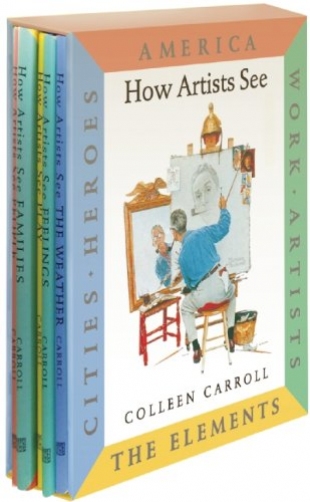Girls and boys are constantly exposed to images in the media and on the Internet. It's important they they learn what to appreciate about them, and ancient and modern art makes a great tutor. How Artists See is a boxed set of six volumes, each on a single theme: America, Heroes, the Elements, Artists, Work, and Cities. Think of this resource as a portable museum of art to foster creativity in kids, to draw out their natural curiosity, to introduce them to a wide cross-cut of creative souls, and to get them used to pluralism as a staple of twenty-first century reality.
Colleen Carroll, an education consultant who taught sixth grade in California, has done a fine job selecting artworks from many different traditions and creative styles. She has also added her own commentaries on the paintings and provided brief biographies, further reading suggestions, and listings of places where to see the artist's work.
How Artists See America tries to present the diversity of the United States and its fragmented cultures in the East, the West, the South, and the Midwest. Our favorites here are Georgia O'Keefe's Summer Days where the desert is a wild and dangerous place, David Hockney's Mulholland Drive: A View From the Studio which reflects the varied terrains of California, and Romare Bearden's New Orleans Ragging Home which uses a marching band as a symbol of the festive undertow of the city.
In How Artists See Heroes, we ponder the actions of Hercules, Joan of Arc, Saint George Killing the Dragon, Ruby Bridges walking into a desegregated school, and Buzz Aldrin standing on the moon.
In How the Artists See the Elements (earth, air, fire, and water) there is plenty to choose from given the popularity of nature painting. Here are gems by Red Grooms, John Constable, Claude Monet, Frederic Remington, and Katsushika Hokusai.
In How Artists See Artists, Carroll hits high stride with material on Norman Rockwell, Marc Chagall, Henri Matisse, and Pablo Picasso.
In How Artists See Work, the eyes are treated to paintings of bringing in the harvest, a quilting bee, making maple syrup, working at night in the office, and laboring in a carpentry workshop.
The last book is How Artists See Cities with creations on buildings, shops, streets, and transportation. The international flavor is evident here with paintings of London, Paris, Venice, New York, and Tokyo.
